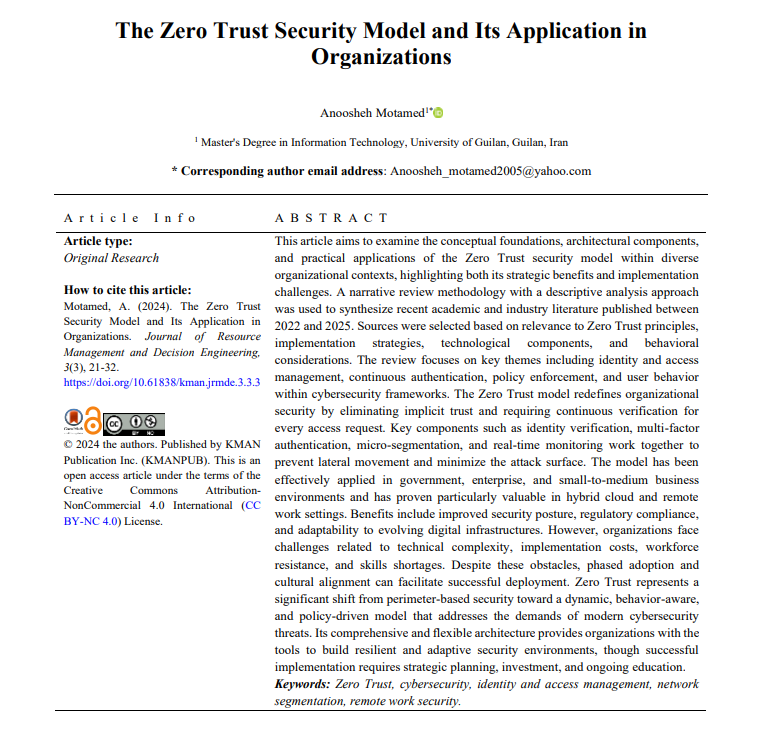The Zero Trust Security Model and Its Application in Organizations
Keywords:
Zero Trust, cybersecurity, identity and access management, network segmentation, remote work securityAbstract
This article aims to examine the conceptual foundations, architectural components, and practical applications of the Zero Trust security model within diverse organizational contexts, highlighting both its strategic benefits and implementation challenges. A narrative review methodology with a descriptive analysis approach was used to synthesize recent academic and industry literature published between 2022 and 2025. Sources were selected based on relevance to Zero Trust principles, implementation strategies, technological components, and behavioral considerations. The review focuses on key themes including identity and access management, continuous authentication, policy enforcement, and user behavior within cybersecurity frameworks. The Zero Trust model redefines organizational security by eliminating implicit trust and requiring continuous verification for every access request. Key components such as identity verification, multi-factor authentication, micro-segmentation, and real-time monitoring work together to prevent lateral movement and minimize the attack surface. The model has been effectively applied in government, enterprise, and small-to-medium business environments and has proven particularly valuable in hybrid cloud and remote work settings. Benefits include improved security posture, regulatory compliance, and adaptability to evolving digital infrastructures. However, organizations face challenges related to technical complexity, implementation costs, workforce resistance, and skills shortages. Despite these obstacles, phased adoption and cultural alignment can facilitate successful deployment. Zero Trust represents a significant shift from perimeter-based security toward a dynamic, behavior-aware, and policy-driven model that addresses the demands of modern cybersecurity threats. Its comprehensive and flexible architecture provides organizations with the tools to build resilient and adaptive security environments, though successful implementation requires strategic planning, investment, and ongoing education.
References
Ali, B., Green, K. M., Daughters, S. B., & Lejuez, C. W. (2017). Distress Tolerance Interacts With Circumstances, Motivation, and Readiness to Predict Substance Abuse Treatment Retention. Addictive behaviors, 73, 99-104. https://doi.org/10.1016/j.addbeh.2017.04.016
Anderson, G. N., Conway, C., & Bravo, A. J. (2023). Distress Tolerance Predicts Substance Use Motivations and Problems in Young Adults Across Four Continents. https://doi.org/10.31234/osf.io/dq8u3
Anderson, G. N., Conway, C., & Bravo, A. J. (2024). Distress Tolerance Is Linked With Substance Use Motivations and Problems in Young Adults Across Four Continents. Journal of personality, 93(3), 706-723. https://doi.org/10.1111/jopy.12963
Baker, S. N., Burr, E. K., Leon, A. N. D., Leary, A. V., Rozek, D. C., & Dvorak, R. D. (2023). The Mediating Roles of Affect Lability and Experiential Avoidance Between Distress Tolerance and Suicidal Ideation Among College Students. Psychological Reports. https://doi.org/10.1177/00332941231216671
Batchelder, A., Ehlinger, P. P., Boroughs, M., Shipherd, J. C., Safren, S. A., Ironson, G., & O’Cleirigh, C. (2017). Psychological and Behavioral Moderators of the Relationship Between Trauma Severity and HIV Transmission Risk Behavior Among MSM With a History of Childhood Sexual Abuse. Journal of Behavioral Medicine, 40(5), 794-802. https://doi.org/10.1007/s10865-017-9848-9
Chaleshtori, M. N., Asgari, P., Heidari, A., Bozorgi, Z. D., & Hafezi, F. (2022). Effectiveness of Mindfulness-Based Stress Reduction Intervention in Distress Tolerance and Sensation-Seeking in Adolescents With a Drug-Addicted Parent. Journal of Research and Health, 12(5), 355-362. https://doi.org/10.32598/jrh.12.5.1889.2
Dhiman, P., Saini, N., Gulzar, Y., Turaev, S., Kaur, A., Nisa, K. U., & Hamid, Y. (2024). A Review and Comparative Analysis of Relevant Approaches of Zero Trust Network Model. Sensors, 24(4), 1328. https://doi.org/10.3390/s24041328
Felton, J. W., Strutz, K. L., McCauley, H. L., Poland, C., Barnhart, K., & Lejuez, C. W. (2019). Delay Discounting Interacts With Distress Tolerance to Predict Depression and Alcohol Use Disorders Among Individuals Receiving Inpatient Substance Use Services. International journal of mental health and addiction, 18(5), 1416-1421. https://doi.org/10.1007/s11469-019-00163-5
Ghanbari, H., Toozandehjani, H., & Nejat, H. (2020). Comparison of the Effectiveness of Acceptance and Commitment Therapy and Quality of Life Improvement Training on Distress Tolerance and Self-Destructive Behaviors in Substance Abusers. International Journal of Basic Science in Medicine, 5(1), 28-32. https://doi.org/10.34172/ijbsm.2020.07
Hayes, A., Dempsey, M., Kells, M., & Murphy, M. (2023). The Relationship Between Social Support, Coping Strategies and Psychological Distress and Positive Mental Well-Being in Carers of People With Borderline Personality Disorder. Borderline personality disorder and emotion dysregulation, 10(1). https://doi.org/10.1186/s40479-023-00237-w
Henschel, A. V., Flanagan, J. C., Augur, I. F., Jeffirs, S. M., & Back, S. E. (2021). Motives for Prescription Opioid Use: The Role of Alexithymia and Distress Tolerance. American Journal on Addictions, 31(1), 55-60. https://doi.org/10.1111/ajad.13230
Huber, B., & Kandah, F. (2024). Zero Trust+: A Trusted-Based Zero Trust Architecture for IoT at Scale. 1-6. https://doi.org/10.1109/icce59016.2024.10444321
Jensen, C. D. (2024). Why Zero Trust Architectures Are Not Replacing Trust. 121-135. https://doi.org/10.1007/978-3-031-76714-2_8
Kechter, A., Barrington‐Trimis, J. L., Cho, J., Davis, J. P., Huh, J., Black, D. S., & Leventhal, A. M. (2021). Distress Tolerance and Subsequent Substance Use Throughout High School. Addictive behaviors, 120, 106983. https://doi.org/10.1016/j.addbeh.2021.106983
Kline, N. K., Cabrera, K. B., & Reed, K. M. P. (2021). Predicting Different Types of Intimate Partner Aggression Perpetration: The Roles of Problem Alcohol Use and Distress Tolerance. Journal of interpersonal violence, 37(13-14), NP10962-NP10984. https://doi.org/10.1177/0886260521990830
Langdon, K. J., Ramsey, S. E., Scherzer, C. R., Carey, K. B., Ranney, M. L., & Rich, J. D. (2020). Development of an Integrated Digital Health Intervention to Promote Engagement in and Adherence to Medication for Opioid Use Disorder. Addiction Science & Clinical Practice, 15(1). https://doi.org/10.1186/s13722-020-00189-4
Molleti, R., & Khanna, A. (2025). End to End Well Architected Zero Trust Architecture in Fintech Cloud Environments. International Scientific Journal of Engineering and Management, 04(01), 1-7. https://doi.org/10.55041/isjem00106
O’Loughlin, C. M., Park, Y., & Ammerman, B. A. (2023). Suicide Ideation, Distress, and Peer Perceptions as Predictors of Substance Use. Substance Use & Misuse, 58(4), 560-569. https://doi.org/10.1080/10826084.2023.2177964
Reese, E. D., Conway, C., Anand, D., Bauer, D. J., & Daughters, S. B. (2019). Distress Tolerance Trajectories Following Substance Use Treatment. Journal of consulting and clinical psychology, 87(7), 645-656. https://doi.org/10.1037/ccp0000403
Sease, T. B., Wiese, A. L., & Knight, K. (2024). A Latent Profile Analysis of Substance Use and Post-Traumatic Stress on Substance Use Treatment Outcomes Among People Involved With the Justice System. Journal of Drug Issues. https://doi.org/10.1177/00220426241248361
Shorey, R. C., Gawrysiak, M. J., Elmquist, J., Brem, M. J., Anderson, S., & Stuart, G. L. (2017). Experiential Avoidance, Distress Tolerance, and Substance Use Cravings Among Adults in Residential Treatment for Substance Use Disorders. Journal of Addictive Diseases, 36(3), 151-157. https://doi.org/10.1080/10550887.2017.1302661
Süzen, A. A., & Ceylan, O. (2024). The Advantages and Implementation Challenges Within the Scope of the Basic Principles of Transition to Zero Trust Architecture. International Journal of 3d Printing Technologies and Digital Industry, 8(3), 416-427. https://doi.org/10.46519/ij3dptdi.1556319
Veilleux, J. C. (2022). A Theory of Momentary Distress Tolerance: Toward Understanding Contextually Situated Choices to Engage With or Avoid Distress. Clinical Psychological Science, 11(2), 357-380. https://doi.org/10.1177/21677026221118327
Wolitzky‐Taylor, K., McBeth, J., Guillot, C. R., Stone, M. D., Kirkpatrick, M. G., Zvolensky, M. J., Buckner, J. D., & Leventhal, A. M. (2016). Transdiagnostic Processes Linking Anxiety Symptoms and Substance Use Problems Among Adolescents. Journal of Addictive Diseases, 35(4), 266-277. https://doi.org/10.1080/10550887.2016.1207969
Yıldız, E., & Büyükfırat, E. (2024). Psychological Flexibility in Individuals With Substance Use Disorder: The Mediating Effect of Distress Tolerance and Stress. Journal of Psychiatric and Mental Health Nursing, 32(3), 610-622. https://doi.org/10.1111/jpm.13140
Zapolski, T. C. B., Rowe, A. T., Banks, D. E., & Faidley, M. T. (2018). Perceived Discrimination and Substance Use Among Adolescents: Examining the Moderating Effect of Distress Tolerance and Negative Urgency. Substance Use & Misuse, 54(1), 156-165. https://doi.org/10.1080/10826084.2018.1512625

Downloads
Published
Submitted
Revised
Accepted
Issue
Section
License
Copyright (c) 2024 Anoosheh Motamed

This work is licensed under a Creative Commons Attribution-NonCommercial 4.0 International License.









